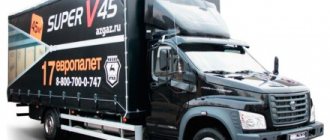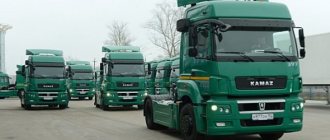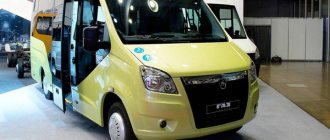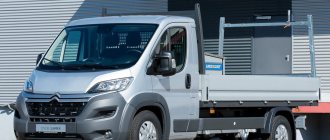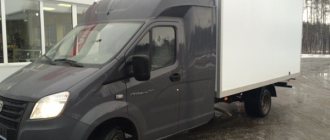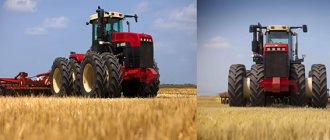The automobile plant on the Oka River is one of the most significant projects of the former USSR. The plant specialized in the production of medium-duty trucks, the history of which is closely connected with the history of the country as a whole. Each car is associated with a certain period. GAZ-AA is a kind of symbol of industrialization, GAZ-51 was mainly used during the period of post-war devastation, GAZ-53 is associated with grandiose construction projects in Siberia. What will GAZon Next become? Feedback from owners after serious testing of the truck will help answer this question.
A little history
It is worth recalling cars such as 3307 and 3309. They have seen a lot in their lifetime, including the collapse of the USSR. But this immediately begs the question: “Does the Russian domestic market need such a car?” Until the 90s, no one doubted the relevance of medium-duty trucks. The reason for this was the lack of roads as such. Under these conditions, the car was used for a variety of purposes, acting as a “universal soldier.” This is due to the lack of other categories of vehicles located between cars and trucks.
At that time, the production of special modifications of GAZ vehicles was established, in particular buses, utility vehicles, vehicles for transporting specific goods (mail, bread), dump trucks, and so on. Their operation was not very efficient and required a large amount of fuel, but there was just a lot of it, and it was very cheap. In general, it was easier for the state to mass produce one type of car without having to develop and produce other models.
Modifications
It is known that in general the “Lawn” line includes ten different variations:
- "Lawn" onboard.
- Onboard “Lawn” with a double cabin and a capacity of 7 seats.
- "Lawn" Europlatform.
- "Lawn" is a manufactured goods van.
- Isothermal van.
- Agricultural dump truck.
- Vacuum machine.
- Construction dump truck.
- Car tow truck.
- Tank truck.
However, the most popular modifications are the City, dump truck and standard cargo variations. The carrying capacity of each of them differs depending on the purpose, as well as some other elements: wheel radius, clearance, height of the loading compartment.
New stage in development
The market economy has shown the right direction in development. Entrepreneurs are more careful with their money and do not want to spend too much. Therefore, the advisability of large cars consuming huge amounts of fuel gradually disappeared. In addition, such machines have never been highly reliable. The company began producing semi-trucks on time, better suited to the needs of small businesses. Models 3307 and 3309 were produced in small numbers mainly for military or other purposes.
The long-awaited release
20 years have passed, and the time has come for the plant to decide on its future plans. The previous model was technically and morally outdated, and in all respects it was inferior to its main competitors: Hyundai HD 78, Mitsubishi Canter. In addition, the car no longer met the ever-tightening safety and environmental requirements. The popularity of opponents, including in the secondary market, made it clear that demand in the 1.5-2 ton segment has been extinguished. The client now doesn’t need carrying capacity, he needs loading volumes.
GAZ decided to correct the situation by releasing the GAZon Next car. Feedback from owners and specialists made it clear that using outdated platforms or creating hybrid versions of existing machines will not yield anything - they will not be able to compete with their main opponents.
Engine Features
"Gazon-Next" offers a choice of two engine options: gas and diesel, YaMZ-534 and YaMZ-534 CNG, respectively. Both guarantee a service life of 700 thousand kilometers, are reliable in operation and meet both Russian and foreign quality and safety standards.
The main difference between the variations is fuel, the decisive factors of which are price and availability. Judging by what owners' reviews say about Lawn-Next, both options are in demand, but the gas option is still considered experimental.
Each variation has its own advantages and disadvantages.
It is known that engines running on gasoline are considered more durable and efficient. This is due to the natural lubrication of engine parts during operation. In the case of gas fuel, the parts are subject to constant cooling and drying. Do not forget about the fire hazard of such devices. Nevertheless, gas fuel is many times more economical.
Technical part
The first cars were released in September last year. In 2015, after modernizing production, GAZ intends to sell about 30,000 GAZon Next units. Journalists were allowed to test drive a car ready for sale even before its large-scale production. This is a regular flatbed truck with a 4x2 wheel arrangement and a platform with a relatively high loading height of 1300 mm. In the near future, the manufacturer will present an urban version with a loading height of 1170 mm. The company assures that the new product has inherited practically nothing from its predecessors. The improved frame from model 3307 and transmission are the main things that the GAZon Next received from its older relatives. Reviews from owners and experts explain the manufacturer’s decision to use the base from an old box by the fact that it will use imported elements. The solution with the frame is not entirely clear to many.
Brief excursion: history of origin
September 2016 is a significant period for Lawn-Next, the time of the release of the first batch of new cars and its testing by specialists. It was possible to pass it before the official press release of the company and the release of the first models for sale. The line is the fifth generation of GAZ trucks, and its production is associated with the company’s desire to comply with environmental and safety standards. For this purpose, a gas engine was used, consuming much less fuel, and updated international standards were met.
"Gazon" is a strong competitor to foreign analogues, while it took little from the original GAZ. Even at the beginning of development, it became clear that the systems of previous models were outdated, so only the old transmission and frame, which had undergone significant changes, were taken as a basis. This line is a kind of successful experiment, a successful attempt to use foreign standards and technologies to create a domestic car. That’s why reviews from real owners talk about Lawn-Next: “Domestic foreign car.”
Engine
In all other respects, the engine is completely new. The main power unit is YaMZ-5344. It is worth noting that the 530th series of YaMZ engines was once awarded the “Best Innovative Technology” award. Version 5344 was a continuation of these reliable motors. The new engine is a 4-cylinder turbodiesel with a displacement of 4.4 liters and a maximum power of 109.5 kW. It is the result of joint work between Yaroslavl and Austrian engineers of the AVL company (in the same way, in the 1980s, engines for the VAZ-2108 model were modified by Porshe employees). The manufacturer used the Common Rail system, but at the same time promised that the fuel equipment would be unpretentious to the quality of fuel for the GAZon Next car. Fuel consumption with this engine averages 19 cubic meters of gas per 100 km.
The engine includes a large number of components from well-known companies in its most important parts (valves, filters, piston rings, etc.). They should significantly increase the reliability and durability of the engine (the warranty period is 3 years or 150,000 km). But their use also entails an increase in the cost of the GAZon Next car, the price of which will play a significant role, especially in the context of the current fall of the ruble. And this immediately begs the question: will a completely domestic car ever be produced?
Gas engine "Gazon-Next"
Owner reviews on the operation of the Lawn-Next gas engine on methane are positive:
- A cheap resource, especially against the backdrop of rising oil prices.
- Good mechanics.
- High performance.
These characteristics attract buyers. The benefits of using compressed gas can amount to almost half a million, because with equal travel costs (approximately 150 thousand kilometers), the cost of gas will be significantly less. However, the problem is the undeveloped infrastructure - gas filling stations are much less common than gasoline ones. At the same time, fuel consumption is 19 cubic meters per 100 km with a volume of 4.43 liters and a power of 150 horsepower.
Domestic foreign car
Other equally important components also used parts from well-known foreign ones: power steering, ZF clutch, electronic engine control systems, ABS, ASR. The front and rear axles are equipped with Wabco disc brakes, Tenneco shock absorbers, and even the radiator is a common Russian-Japanese design. At the same time, the level of localization declared by the manufacturer is 90%. The figures are justified purely formally, if we take the total weight of our frame, axle and body.
New cabin
The cabin deserves special attention. The company has developed a unified line of products. For the first time, one of them was “put on” on the new generation GAZelle, and now on the GAZon Next. Reviews from owners, photos and opinions of experts allow us to verify the ergonomics and relatively high level of comfort inside the cabin. The basic equipment of the new product includes heated side mirrors and seats, and electric windows. The use of galvanized sheet protects the cabin from corrosion, and some elements are completely plastic.
High quality painting is another advantage of the GAZon Next car. Feedback from owners of previous GAZ products spoke of significant problems in this regard. The manufacturer decided to rectify the situation, so the body of the new product is painted along with the popular Mercedes-Benz Sprinter, the assembly of which is also organized at the GAZ enterprise.
Characteristics of diesel engine
As for the diesel engine, reviews from owners of the Lawn-Next YaMZ version 534 are no less favorable. Having received the “Best Innovation” award at one time, the engine meets safety and quality standards. Fuel consumption is only 18 liters per hundred kilometers, that is, approximately 28 thousand liters of fuel per year. It was developed with the support of an Austrian company, a leader in the engineering field. Its power is 134.5 horsepower.
"GAZon Next": photo, design
In the design of the car, despite the completely new cabin and body, features of many predecessors are noticeable. For example, the layout solutions included in the frame of the gas car are the same - the hood layout remains unchanged. This solution leads to a reduction in the useful length of the body, despite the developers' talk about increasing the level of passive safety. It is important to note that the main opponents have a capless layout.
Legislative standards do not make it possible to simply increase the rear overhang, and every additional meter in urban conditions will be unnecessary. And this despite the fact that marketers were primarily counting on the city version of the car. The longest wheelbase version of the truck is 8 meters. Another drawback is the use of 19.5-inch wheels (20-inch wheels are installed on the base model), when 17.5-inch wheels would be a good option for a GAZon Next car. The price of the latter is a third cheaper.
The design of the front bumper led to controversy. And even taking into account the fact that it was made of iron and not plastic, the size of the footrest is insufficient. For example, if the driver is wearing size 45 boots, he will not be able to stand on them with his full foot while working under the hood - he will not be able to rest on his heels, and he will not be able to stand on his toes for long. The manufacturer indicates safety standards, but in any case, inconvenience will arise.
First tests
For some reason, the manufacturer decided to show the driving qualities of the model on a closed track. In addition, a large number of journalists conducting test drives did not have category “C” licenses, so they were provided with impressions. There are no complaints about the ease of getting in and out, visibility for the driver and the ergonomics of the seats with many adjustments - here the designers have earned a solid “five”.
The standard cabin now has one more passenger seat. An option with a maximum number of seats – up to seven – is also available. An aluminum body is also available as an option. The cabin of the GAZon Next car is quite spacious, but there are clearly not enough niches on the rear wall for small things. There is a warning in the cabin indicating that it is necessary to adjust the seat to a certain weight of the driver before driving. Otherwise it may break. The dashboard came from the new generation of the GAZelle, and the shape of the gearshift lever has not changed at all. Large side mirrors provide such good visibility that drivers replacing each other do not even adjust them to their height.
GAZon Next with double cab
The automobile plant also produces new GAZONS with a double cab; the cabin can accommodate up to seven people, including the driver. In such a car it is convenient to transport a group of workers; the car can be used as a mobile workshop or work in agriculture. The back row of this cabin seats 4 people. Alternatively, the back row of seats can be transformed into a sofa, using it as a sleeping place.
The LAWN with a two-row cab has a load capacity of 4.5 tons, the length of the platform is 3.6 m. The car plant also produces modifications with an extended body - 5.1 m and 6 m.
Driving a GAZon Next car
Reviews indicate quite strong vibration in the car interior. Even taking into account the 4-cylinder diesel engine, its level is unreasonably high. This is a consequence of saving on engine suspension. If you don’t touch the controls, you can sit quite comfortably, since the chair effectively dampens external stimuli. But even so, strong vibration causes the gears in the transmission to knock. As the speed increases, the situation improves slightly.
The box deserves due attention. If the performance of the first and reverse gears leaves much to be desired, then from the second to the fifth the situation is completely opposite. In general, imported spare parts are completely worth the money, which directly affects the well-coordinated operation of the transmission. The new GAZon Next, even in a semi-loaded state, can fully start from second gear. The vehicle's carrying capacity reaches 8 tons.
Behind the wheel there is a feeling of driving a passenger car: an informative steering wheel, clear and error-free gear shifting, reliable brakes, “soft” pedals (the distance between the gas and brake pedals should be increased, since it would be uncomfortable to press them with your feet, for example, in felt boots ).
Racing truck
Although the race track is intended for sports cars, the new truck was tested there as well. It is almost impossible to get him into a skid. Correct weight distribution made the model flexible: the tires grip the road tenaciously, and the stabilization system (available as standard) works flawlessly. Despite the 8-ton weight of the truck, the disc brakes work clearly and reliably.
Good visibility and practically “passenger-like” controls allow you to maneuver the “snake” without any problems, park in reverse, brake or accelerate in a narrow passage. Even taking into account the fact that the restrictive cones were very dense, the greater number of journalists in the race was practically not inferior to the factory drivers. The company's press service stated that representatives of driving schools showed interest in the truck. It's easier to pass the test with a new car. They plan to replace the old 3307.
Advantages and disadvantages
The initial cost of 1,000,000 rubles increased to 1,300,000 rubles, therefore, the GAZon Next car moved to a different price category. For example, the popular Mitsubishi Fuso, which is superior to the new product in all respects, costs in the range of 1,500,000-1,700,000 rubles. The use of imported parts leads to an increase in the cost of the truck, but representatives of the GAZ company assured that its owners will be able to save significantly on its repairs.
According to calculations, the cost of operating the new product will be lower by 12-17%. Parts from foreign manufacturers, although not elite, are quite reliable. Therefore, the manufacturer increased the service interval by 20,000 km. Another significant plus is the warranty service for three years (150,000 km).
Specifications
The manufacturer declared the service life of the new Lawn Next truck to be 800 thousand km. Spare parts for a new truck are available both in price and availability - you don’t need to order them or wait long. There are many imported parts installed on the LAWN:
- Power steering pump, steering gear and clutch – ZF;
- Driveshaft – Dana Spicer;
- Shock absorbers – Tenneco;
- Brake system - Wabco.
Compared to the previous model 3307, the new truck’s carrying capacity has been increased from 4.5 to 5 tons, but this is not a fact that the commercial owners will not overload the vehicle. The frame has now become stronger, you can experiment.
Various types and modifications of cars based on GAZ Next
General characteristics of GAZon Next:
- Dimensions (length/width/height) – 6.43/2.3/2.41 m, height is taken according to the cabin;
- Length (with extended base) – 7.91 m;
- Ground clearance - 26.2 cm;
- Front/rear wheel track – 1.74/1.69 m;
- Distance between axles (wheelbase) – 3.77 m (with extended wheelbase – 4.51 m);
- Transmission - 5 speed manual transmission;
- Load capacity – 5 tons;
- Curb weight – 3.7 tons;
- The weight of a fully loaded car is 8.7 tons;
- The maximum permissible constant speed is 110 km/h;
- Fuel consumption for lawn next (highway) – 18l/100 km;
- Wheel radius – R20;
- Brake system – pneumatic type, disc;
- Platform length – 3.6 m (for extended base – 5 m).
The basic configuration of the Next onboard lawn comes with a steel body; an aluminum platform can be installed as an option.
The YaMZ 534 diesel engine standardly installed on the LAWN meets Euro-4 and Euro-5 environmental standards. The engine is quieter than the Belarusian D-245; according to technical specifications, fuel consumption at a speed of 60 km/h should be 13.6 liters, at 80 km/h – 18 liters.
